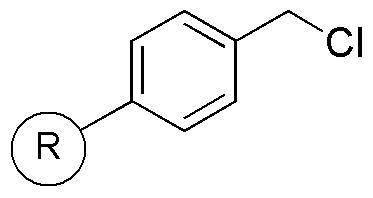Chloromethylated polystyrene is widely utilized in research focused on:
- Ion Exchange Resins: This chemical serves as a key component in ion exchange resins, which are essential in water purification and softening processes, effectively removing unwanted ions from solutions.
- Catalysis: It acts as a support material for catalysts in various chemical reactions, enhancing reaction rates and selectivity, particularly in organic synthesis.
- Polymer Chemistry: Researchers use it to create functionalized polymers, allowing for the development of materials with tailored properties for specific applications, such as drug delivery systems.
- Adsorption Processes: Its porous nature makes it suitable for adsorption applications, such as capturing pollutants from air or water, contributing to environmental remediation efforts.
- Composite Materials: It is incorporated into composite materials to improve mechanical strength and thermal stability, which is crucial in industries like automotive and aerospace.
General Information
Properties
Safety and Regulations
Applications
Chloromethylated polystyrene is widely utilized in research focused on:
- Ion Exchange Resins: This chemical serves as a key component in ion exchange resins, which are essential in water purification and softening processes, effectively removing unwanted ions from solutions.
- Catalysis: It acts as a support material for catalysts in various chemical reactions, enhancing reaction rates and selectivity, particularly in organic synthesis.
- Polymer Chemistry: Researchers use it to create functionalized polymers, allowing for the development of materials with tailored properties for specific applications, such as drug delivery systems.
- Adsorption Processes: Its porous nature makes it suitable for adsorption applications, such as capturing pollutants from air or water, contributing to environmental remediation efforts.
- Composite Materials: It is incorporated into composite materials to improve mechanical strength and thermal stability, which is crucial in industries like automotive and aerospace.
Documents
Safety Data Sheets (SDS)
The SDS provides comprehensive safety information on handling, storage, and disposal of the product.
Product Specification (PS)
The PS provides a comprehensive breakdown of the product’s properties, including chemical composition, physical state, purity, and storage requirements. It also details acceptable quality ranges and the product's intended applications.
Certificates of Analysis (COA)
Search for Certificates of Analysis (COA) by entering the products Lot Number. Lot and Batch Numbers can be found on a product’s label following the words ‘Lot’ or ‘Batch’.
*Catalog Number
*Lot Number
Certificates Of Origin (COO)
This COO confirms the country where the product was manufactured, and also details the materials and components used in it and whether it is derived from natural, synthetic, or other specific sources. This certificate may be required for customs, trade, and regulatory compliance.
*Catalog Number
*Lot Number
Safety Data Sheets (SDS)
The SDS provides comprehensive safety information on handling, storage, and disposal of the product.
DownloadProduct Specification (PS)
The PS provides a comprehensive breakdown of the product’s properties, including chemical composition, physical state, purity, and storage requirements. It also details acceptable quality ranges and the product's intended applications.
DownloadCertificates of Analysis (COA)
Search for Certificates of Analysis (COA) by entering the products Lot Number. Lot and Batch Numbers can be found on a product’s label following the words ‘Lot’ or ‘Batch’.
*Catalog Number
*Lot Number
Certificates Of Origin (COO)
This COO confirms the country where the product was manufactured, and also details the materials and components used in it and whether it is derived from natural, synthetic, or other specific sources. This certificate may be required for customs, trade, and regulatory compliance.


